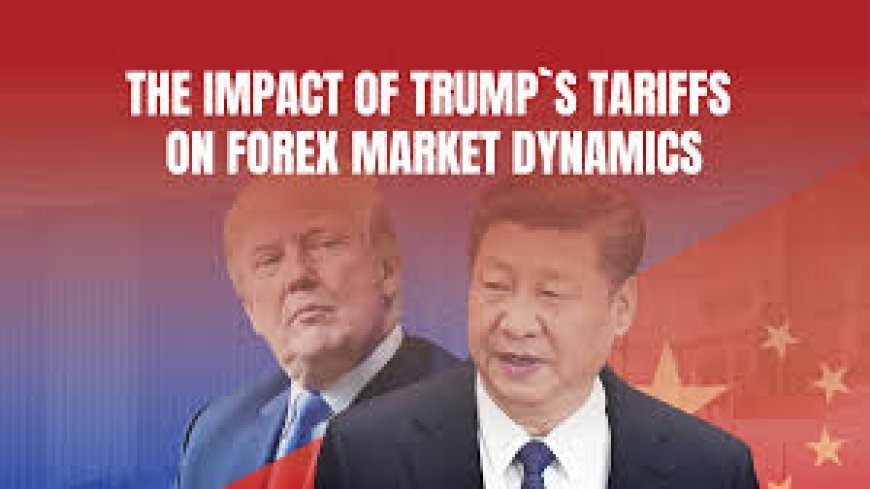News by apibottrade: The Impact of the President’s Words on Market Stability
This ambiguity forces investors and traders to make assumptions about future policy in the absence of defined parameters. In such circumstances, even minor shifts in tone can trigger significant market reactions—across

In today’s volatile geopolitical and economic climate, the words of a president can be just as powerful as policy itself. Markets no longer move solely in response to legislative action or economic indicators—they respond instantly to tone, timing, and messaging.
Under President Trump, tariff announcements and assertive rhetoric have repeatedly triggered market swings, exposing the fragility of investor confidence in an age where communication is strategy.
This article examines how presidential language influences market stability, reshapes expectations, and transforms investment behavior—turning every statement into a potential market-moving event.
Strategic realignment or economic disruption?
Recalibrating global trade
In an era characterized by unprecedented political influence over global trade dynamics, the recent decision by President Trump to impose a 90-day tariff freeze, while setting a minimum tariff limit of 10% for all countries except China, serves as a stark reminder of the potent impact political decisions can wield over financial markets. This bold move, part of a broader trade strategy aimed at renegotiating more favorable terms for the United States, has not only highlighted the significant sway governmental actions hold but also stressed the delicate balance that must be maintained to ensure market stability.
The strategic objective
The backdrop of these tariff adjustments lies within an overarching effort by the United States to recalibrate its position in the global trade architecture. Driven by the belief that existing trade agreements disproportionately disadvantage American interests, the Trump administration has pursued an aggressive strategy aimed at reshaping long-standing economic relationships. Central to this approach is the unilateral imposition of tariffs used both as a punitive measure and a negotiating tool—especially targeting countries that run significant trade surpluses with the U.S.
China in focus. Pressure, isolation, and leverage
China, as the world’s second-largest economy and the United States' foremost strategic competitor, has remained at the heart of this trade confrontation. By deliberately excluding China from the 90-day tariff freeze and maintaining elevated tariffs on Chinese imports—retaliatory in nature due to China’s own countermeasures—the U.S. has reinforced its intention to keep economic pressure until significant structural reforms and concessions are secured. At the same time, other trading partners have been offered temporary relief, albeit with a condition of a minimum 10% tariff. This dual-track approach serves both to diplomatically isolate China and to foster bilateral negotiations with other strategically aligned nations.
The economic costs of coercion
However, using tariffs as instruments of economic coercion carries substantial risks. Such policies frequently disrupt global supply chains, elevate input costs for domestic industries, and provoke retaliatory actions that can snowball into broader trade wars. Moreover, the administration’s unpredictable communication style—marked by impromptu, assertive, and open-ended public statements—further amplifies market uncertainty.
Markets demand clarity, not ambiguity
Financial markets thrive on clarity, stability, and forward guidance. When decisive, predictable policy signals are replaced by ambiguous or sudden shifts in tone, risk premiums increase, volatility is heightened, and investors tend to pull back from long-term commitments.
Unintended consequences of strategic messaging
Beyond the economic rationale behind tariffs, it is the mode of communication that compounds market instability. The mix of aggressive trade measures with inconsistent rhetoric adds an extra layer of complexity, challenging market participants and disrupting an already fragile global economic environment.
How language shapes risk perception and investment behavior
The power of presidential language is formidable. Often characterized as “arrogant,” “provocative,” or “unorthodox,” the president’s remarks have become a significant market-moving factor. Terms like “flexibility,” “negotiation,” and “case-by-case”—intended to convey strategic adaptability—often introduce a high degree of interpretative ambiguity, leading to uncertainty and volatility.
Ambiguity fuels volatility
This ambiguity forces investors and traders to make assumptions about future policy in the absence of defined parameters. In such circumstances, even minor shifts in tone can trigger significant market reactions—across equities, bonds, currencies, and commodities—resulting in persistent volatility.
Behavioral economics at play
From a behavioral standpoint, this uncertainty amplifies cognitive biases such as anchoring, herding, and loss aversion. Traders may hurriedly reposition their portfolios in anticipation of worst-case scenarios, while institutional investors might reduce their risk exposure—all of which can lead to mispriced assets and liquidity dislocations.
The erosion of investor confidence
Furthermore, inconsistent leadership communication erodes the foundational trust needed for stable market functioning. Over time, this dynamic discourages long-term investment, distorts capital flows, and incentivizes reactive rather than strategic decision-making.
Rhetoric as a systemic risk
While strong rhetoric may be leveraged for political posturing or negotiation tactics, its unintended effects in the financial world are substantial. A lack of disciplined, transparent communication—especially on globally impactful issues—poses a systemic risk, undermining market stability and eroding investor confidence. It is therefore critical for investors to scrutinize not only the policies themselves but also the tone and consistency of the messaging that accompanies them.
Learning from the past – When sudden policy shifts reshape global markets
The Nixon Shock: Ending Bretton Woods Without Warning
History provides important lessons. One of the most notable examples is the Nixon Shock of 1971, when President Richard Nixon unexpectedly suspended the U.S. dollar’s convertibility into gold. This abrupt move dismantled the post-World War II Bretton Woods system, triggering widespread currency volatility and instilling long-term uncertainty in international monetary relations. The lesson here is that even necessary structural reforms can destabilize global systems if not communicated with a coordinated strategy.
Modern echoes: The rhetoric and reality of today’s trade policy
Similar patterns are evident in recent tariff announcements by the Trump administration. Issued with little warning and accompanied by ambiguous language, these measures have destabilized investor expectations and heightened uncertainty in the markets.
The Smoot-Hawley Tariff Act: A Historical Cautionary Tale
Another historical parallel is the Smoot-Hawley Tariff Act of 1930, which, despite its goal of protecting domestic industries, triggered retaliatory tariffs and deepened the global economic crisis. This episode serves as a stark reminder that protectionist measures—when executed without multilateral coordination—can backfire dramatically.
The value of strategic foresight and global coordination
Reflecting on these events underscores the risks of unilateral or ideologically driven policymaking. Well-intentioned policy shifts can misfire if they fail to consider global interdependencies, investor psychology, market timing, and the need for clear, consistent communication.
The mind game of expectations – Investing between security and growth
At its core, investing is as much a psychological endeavor as it is an analytical one. It involves balancing the desire for security with the pursuit of growth amid unpredictable policy shifts. When statements by influential policymakers, like those of President Trump, disrupt clarity, they alter the psychological anchors on which investment decisions are based.
Navigating between security and growth
Investors tend to split into two camps under uncertainty: • Security-seeking investors retreat to safe havens like U.S. Treasuries, gold, or the Swiss franc to preserve capital. • Growth-focused investors, in contrast, seek opportunities hidden within market volatility—such as undervalued stocks or sectors set to benefit from policy shifts.
The key is knowing when uncertainty offers opportunity and when risk is merely noise versus systemic danger. Analyzing presidential rhetoric, understanding its intent, and discerning its longer-term implications can make all the difference in successfully navigating modern markets.
Stability, strategy, and the psychology of markets
The dynamic interplay between policy, communication, and market psychology is at the heart of modern investing. As evidenced by recent events, ambiguous or aggressive rhetoric increases market volatility, disrupts investor expectations, and ultimately reshapes risk appetites. Success does not come from reacting impulsively to headlines; it comes from mastering expectation management, balancing caution with confidence, and positioning portfolios to thrive even amid uncertainty.
In conclusion, while markets may bend under political pressure, they are ultimately resilient. For those who can read between the lines—recognizing risk where others see chaos and finding opportunity amid turmoil—today’s turbulence may well become tomorrow’s competitive advantage.
What's Your Reaction?
 Like
0
Like
0
 Dislike
0
Dislike
0
 Love
0
Love
0
 Funny
0
Funny
0
 Angry
0
Angry
0
 Sad
0
Sad
0
 Wow
0
Wow
0

















